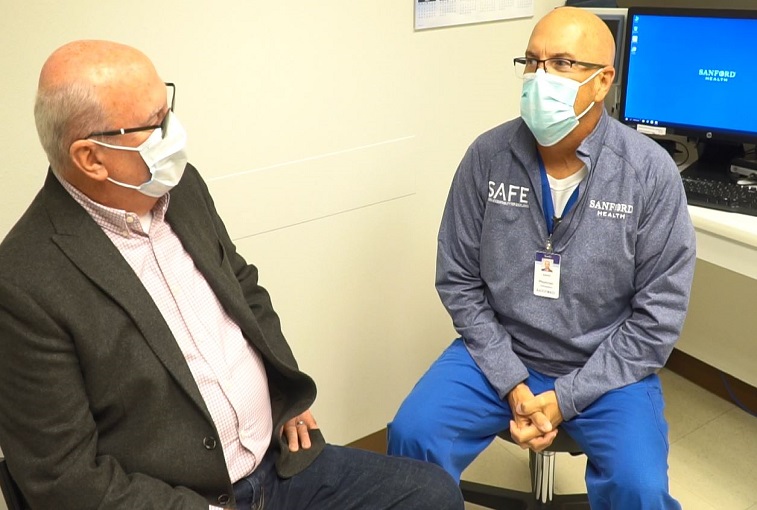Mark Hawks has always been a relatively active guy. But pain in his knees started interfering on his quality of life.
“The pain got to the point where I could walk about three quarters of a mile and I had to sit down,” said Hawks, a Sanford Health patient in Bismarck, North Dakota. “I could stand for maybe 10 minutes and then I’d have to sit down. I couldn’t go up and down ladders. So that’s what drove me to do something about it.”
Hawks first talked with his Sanford primary care provider about the pain. He was prescribed some pain medications which helped him a little bit, but didn’t work in the long run.
“When that stopped working he did some steroid shots,” Hawks said. “Which helped for a few months, but then it was back again.”
That’s when Hawks was referred to the Sanford Orthopedics and Sports Medicine clinic in Bismarck, North Dakota.
“Mark was a good example of someone who really benefited from our comprehensive total joint optimization program,” said Hawks’ orthopedic surgeon, Dr. David O’Regan. “He saw our orthopedic navigator ahead of time who helped him optimize his health, such as lose a little weight. He got into physical therapy right away and was exercising beforehand so he was in good shape before his surgery.”
Navigating knee surgery with a guide
The optimization program evaluates five areas of risk for patients and helps them get into optimal condition to ensure the best possible outcome.
Through Sanford Orthopedics and Sports Medicine, the program helps patients on their entire journey. They guide a patient through choosing surgery, prepping for surgery and recovering from their surgery.
Gina Pich is the orthopedic nurse navigator in Bismarck. She helps customize the best care plan for each patient.
“I ensure that all patients coming through for their elective procedure are as healthy as they possibly can be,” Pich said. “So say you have a history of heart disease or stroke, we make sure you see all of those specialists beforehand to make sure you are in optimal shape or condition before your surgery.”
After Hawks talked with Pich, he began exercising and lost a little weight. He was then ready for surgery.
“Both knees were going bad,” said Hawks. “It started with my left knee, and then as that one was going bad, my right knee started going bad. So I asked if I could do both knees at the same time and he said he felt like I was a good candidate so I did both knees at the same time.”
Results for the long run
The optimization program can also get patients signed up to do a blood test through the Sanford Chip. This allows providers to customize medications based on a patient’s health history and DNA. For Hawks, the Sanford Chip results helped his providers change his cholesterol medication to one that worked better for him.
Surgery day came in 2017. After spending two days in the hospital and beginning therapy, Hawks was ready to go home.
“He progressed super, super quickly,” said Jess Friedt, a physical therapist at Sanford Health in Bismarck. “A large part of that was education with the whole team and also his motivation and knowing what his goals were.”
Dr. O’Regan says therapy is extremely important in the patient’s recovery. Especially in a patient like Hawks who had a bilateral total knee replacement.
“Equally important is the patient’s recovery and their effort in the rehabilitation process through physical therapy,” said Dr. O’Regan. “But, not everyone is the same. Some people require more therapy. They may have more pain or stiffness. Others need less, because they may do very well. But the therapy and recovery is equally important as how well the surgery is done.”
For Hawks, his hard work in physical therapy paid off. It’s still paying off three years after surgery.
“It was a very successful surgery for me and I’m glad I did it because I’ve got my lifestyle back,” Hawks said. “I like walking, hiking, camping and home improvement projects. I’ve been able to do all of those, which I wouldn’t have been able to do without the surgery.”
Learn more
- Diligent rehab after knee replacements pays off
- Postponed knee surgery greeted with efficiency at Sanford
- Orthopedic walk-in clinics offer more convenience, fast care
…
Posted In Orthopedics, Specialty Care, Sports Medicine

